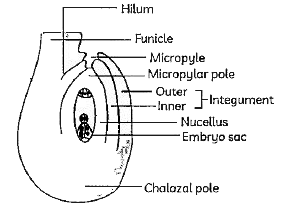Embryo sacs of some apomitic species appear normal but contain diploid cells. Suggest a suitable explanation for the condition.
It is true that many apomicts possess normal looking embryo sacs. The only possibility of the embryo sac possessing diploid cells is due to failure of meiotic division at the megaspore mother cell stage. Since the megaspore mother cell has a diploid nucleus, if it undergoes mitosis instead of meiosis all the resulting nuclei and cells will be diploid in nature.
Topper's Solved these Questions
- REPRODUCTIONBOOK - TRUEMAN BIOLOGYCHAPTER - REPRODUCTIONEXERCISE - SECTION -C
22 Videos
- Protista BOOK - TRUEMAN BIOLOGYCHAPTER - Protista EXERCISE - ASSERTION AND REASON
5 Videos
- Reproduction In OrganismsBOOK - TRUEMAN BIOLOGYCHAPTER - Reproduction In OrganismsEXERCISE - MULTIPLE CHOICE QUESTION
128 Videos
Similar Questions
Select the correct statements about apomitic seeds.a)these seeds are produced from fertilies ovules,b) they contain diploid embryos in diploid plants,c) Zygotic embryo is genetically identical to the apomitic embryo hence two embryos can be called clones
View SolutionMegasporogenesis is defined as the process of formation of megaspores from the megaspore mother cell (MMC). MMC is a diploid cell This process occurs inside the nucellus of the developing ovule.

The fate of polar nuclei in the embryo sac is:
View Solution
Knowledge Check
In some plants, megaspore mother cell does not divide by meiotic division, instead from an unreduced embryosac, containing diploid egg cell. This condition is referred as
ASporophytic buddingBPolyembryonyCRecurrent agamospermyDParthenocarpyDr. Johnson has discovered an amazing species of yeast that can grow on high quantity chocolate bars. He discovered a particular species when chocolate was not available, a diploid cell (2n = 32) can divide by meiosis producing four haploid spores and the same cell undergoes mitosis, how many chromo- somes will each resulting cell contain?
A16 and 8B8 and 32C32 and 16D16 and 32A typical angiosperm embryo sac contains 8 nucleus and 7 cells. These 8 nucleus are formed by ………..
A4 mitotic divisionsB7 mitotic divisionsC5 meiotic divisionsD4 meiotic divisions
What interests many people is the possibility of finding an Earth-like planet, and many science fiction storeis have been woven around the possibility of there existing a planet somewehre in the universe which is an exact replica of the Earth. There are too many variable quantities for this to be a possibility worth considering. What is possible, if planetary systems are common as they seen to be, is the existence of planets where the conditions are similar to conditions on the Earth and to which our form of life could rapidly adpt. In life had gained a foothold on such a planet , it is possible that life closely paralleling our own planet could have developed.
What sort of conditions is necessary for life as we know it to develop? First of all of course a suitable planetary body is essential. Given this, then two vital conditions must be satisfied. The temperature must be neither too hot nor too cold, since intense heat breaks down organic molecules and severe cold prevents activity from going on. Too much short wave radiation also upsets living organisms. The other prerequisite is a suitable atmosphere sufficiently dense to give protection from radiation and meteorites and containing oxygen and water vapour in reasonable quantities.
This passage suggests that there
View SolutionCentral cell of embryo sac contains
View SolutionWhen a cell contains some nondiffusible or fixed ions which are kept balanced by diffusible ions of opposite charge , this condition is known as
View SolutionWhen a cell contains some nondiffusible or fixed ions which are kept balanced by diffusible ions of opposite charge , this condition is known as
View SolutionRead the following statements
(a) Angiosperms range in size from microscopic Wolffia to tall trees of Eucalyptus
(b) In angiosperms, the seeds are enclosed by fruits
(c ) Double fertilization is an event unique to angiosperms
(d) In angiosperms, each cell of embryo sac is diploid
(e) In angiosperms, the zygote develops into an endosperm
Of the above statements, the correct ones are
View Solution
